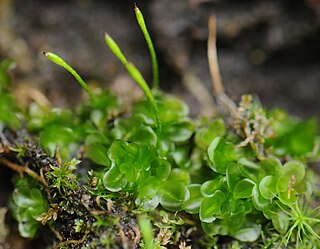Related Research Articles

Buxbaumia is a genus of twelve species of moss (Bryophyta). It was first named in 1742 by Albrecht von Haller and later brought into modern botanical nomenclature in 1801 by Johann Hedwig to commemorate Johann Christian Buxbaum, a German physician and botanist who discovered the moss in 1712 at the mouth of the Volga River. The moss is microscopic for most of its existence, and plants are noticeable only after they begin to produce their reproductive structures. The asymmetrical spore capsule has a distinctive shape and structure, some features of which appear to be transitional from those in primitive mosses to most modern mosses.
Coslett Herbert Waddell (Rev.) was an Irish priest,, and botanist.

Pleurozium schreberi, the red-stemmed feathermoss or Schreber's big red stem moss, is a moss with a loose growth pattern. The root name pleuro comes from the Latin for ribs, possibly describing how the parts branch from the stem.

Bryology is the branch of botany concerned with the scientific study of bryophytes. Bryologists are people who have an active interest in observing, recording, classifying or researching bryophytes. The field is often studied along with lichenology due to the similar appearance and ecological niche of the two organisms, even though bryophytes and lichens are not classified in the same kingdom.

Meesia triquetra, the three-ranked hump-moss, is a moss that occurs all around the northern hemisphere in higher latitudes.

Oedipodium is the only genus of moss in the family Oedipodiaceae. It contains the single species Oedipodium griffithianum, the gouty-moss or Griffith's oedipodium moss. This species is distributed in cooler climates of Eurasia, as well as from Alaska, Washington state, British Columbia, Yukon, Greenland, Newfoundland, Tierra del Fuego and the Falkland Islands.

Discelium is the only genus of moss in the family Disceliaceae; it contains the single species Discelium nudum, the flag-moss. This species is rare, but is widely distributed in cool and temperate climates of the Northern Hemisphere.
The Bryologist is a peer reviewed scientific journal specializing in bryology. It is published quarterly by the American Bryological and Lichenological Society (ABLS). It began as a department of The Fern Bulletin devoted to the study of North American mosses. Its first editor was Dr. Abel Joel Grout, who intended the bulletin to be "enabling any one at all interested in mosses to get some knowledge of these plants without excessive labor or expense ... the editor will also try to identify for subscribers difficult specimens accompanied by notes and return postage."
The Botanical Society of America (BSA) represents professional and amateur botanists, researchers, educators and students in over 80 countries of the world. It functions as a United States nonprofit 501(c)(3) membership society.
Bryum dixonii, commonly known as Dixon's threadmoss, is a moss endemic to Scotland. The species occupies montane habitats, and although rare it has a wide distribution including the central and north-west Highlands, and the islands of Skye, Rùm and St Kilda. Originally discovered on Ben Narnain, Argyll, in 1898 by Hugh N. Dixon, it was not seen again until 1964 when found by Ursula Duncan at Juanjorge in Glen Clova in Angus. As of 2000 there was no species action plan for its protection.
Hiroshi Inoue was a Japanese botanist specializing in bryology.

The American Bryological and Lichenological Society is an organization devoted to the scientific study of all aspects of the biology of bryophytes and lichen-forming fungi and is one of the nation's oldest botanical organizations. It was originally known as the Sullivant Moss Society, named after William Starling Sullivant. The Society publishes a quarterly journal distributed worldwide, The Bryologist, which includes articles on all aspects of the biology of mosses, hornworts, liverworts and lichens. The Society also publishes the quarterly journal Evansia, which is intended for both amateurs and professionals in bryology and lichenology and is focused on North America.

Phaeoceros laevis, the smooth hornwort, is a species of hornwort of the genus Phaeoceros. It is commonly found in areas where moisture is plentiful, such as moist soils in fields, the banks of streams and rivers or inundated beneath the surface of the rivers. It grows to a maximum height of about 5 millimetres and the plants are monoecious; the sex organs are visible on the dorsal surface.
The British Bryological Society is an academic society dedicated to bryology, which encourages the study of bryophytes. It publishes the peer-reviewed Journal of Bryology.
Leopold Loeske was a German watchmaker and amateur bryologist.
A.L. Kathleen King (1893–1978) was an Irish botanist and one of Ireland's leading field bryologists.

Hookeria lucens, the shining hookeria, is a species of moss in the family Hookeriaceae. It is native to Europe, east to the Caucasus, Turkey and China, as well as Scandinavia and the Faeroe Islands and western North America.
Geneva Sayre was an American bryologist and bibliographer. She "pioneered bibliographical and historical bryology, a new field in the study, evaluation, and organization of the literature of bryology."
Harvey Alfred Miller was an American botanist, specializing in Pacific Islands bryophytes.
Jean Annette Paton is a British botanist, bryologist and botanical illustrator. She has written many books on the bryology of the United Kingdom and the flora of Cornwall, and described several new species.
References
- ↑ Schofield, W. B. (1985). Introduction to Bryology. New York: Macmillan. p. 268. ISBN 0-02-949660-8.
- ↑ "Bryological journals" . Retrieved 2009-11-30.